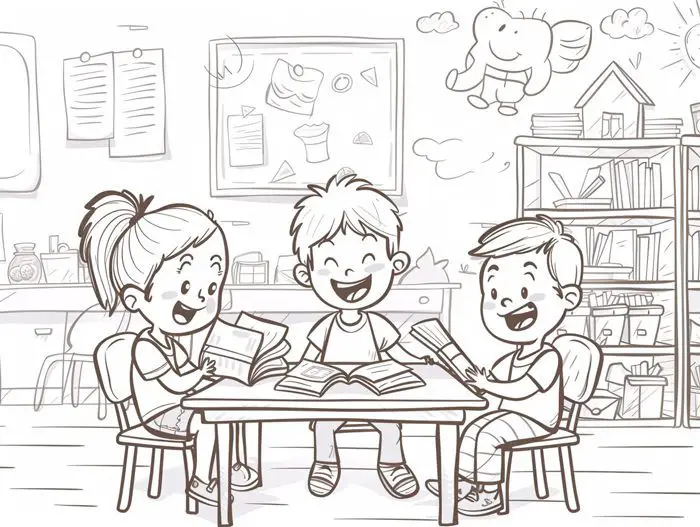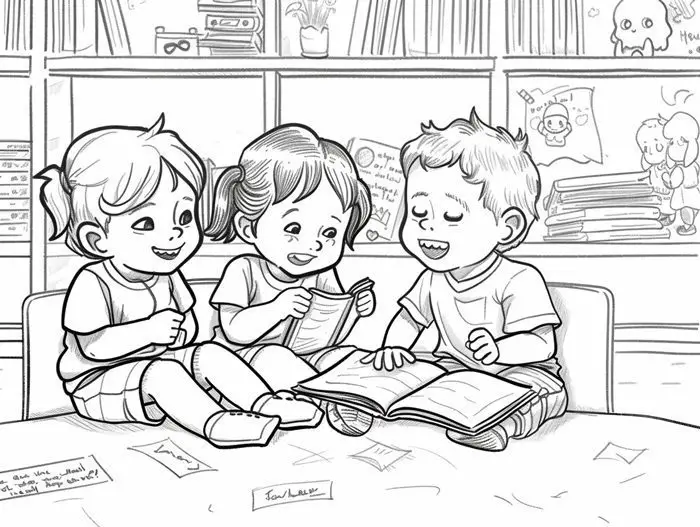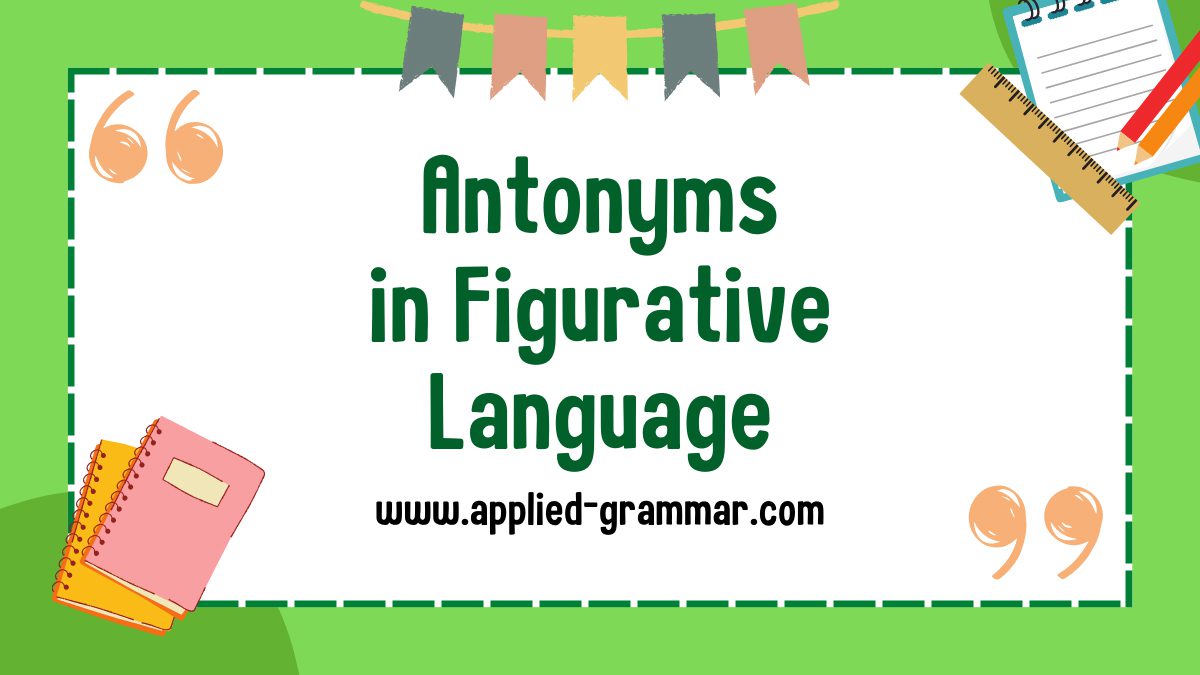Are you fascinated by the power of language to convey meaning in unexpected ways? Do you love exploring the depths of figurative language and its ability to paint vivid pictures in our minds? If so, get ready to jump into the world of antonyms in figurative language.
Antonyms, or words that express opposite meanings, are not just limited to literal language. They also play a crucial role in figurative expressions, adding depth and nuance to our understanding. In this text, we will explore how antonyms are used in metaphors, one of the most powerful forms of figurative language.
Metaphors allow us to make connections between seemingly unrelated things, and antonyms can serve as the perfect tool to create striking contrasts. We will investigate into examples of metaphors that employ antonyms, revealing the hidden layers of meaning that lie beneath the surface. So, get ready to expand your linguistic horizons and discover the magic of antonyms in figurative language.
Key Takeaways
- Antonyms are words that have opposite meanings and can be used in figurative language to create striking contrasts and add depth to expressions.
- Figurative language goes beyond literal meaning, using metaphors, similes, and personification to evoke emotions, create vivid images, and convey abstract ideas.
- Examples of antonyms in figurative language include contrasting emotions in similes (“bright as the sun, but dark as night”), intense love in metaphors (“frozen wasteland, empty and desolate”), and contrasting movements in personification (“flowers danced, while trees stood stoic”).
- Incorporating antonyms in figurative language adds depth to descriptions, creates visual imagery, and emphasizes contrasts, making writing more engaging and memorable.
- Strategies for incorporating antonyms include selecting opposite words that are contextually relevant, emotionally resonant, and visually impactful, using antonym pairs in similes, metaphors, and personification, and exploring different contexts in which antonyms can be utilized effectively.
- Common mistakes to avoid are overusing antonyms, forcing them into sentences, and using antonyms that don’t fit the context. It’s important to strike a balance and use antonyms selectively and deliberately to enhance the impact of figurative language.
Definition of Antonyms in Figurative Language

What are Antonyms?
Antonyms are words that have opposite meanings. They are words that convey contrasting ideas or concepts. For example, “hot” and “cold” are antonyms because they represent contrasting degrees of temperature. Antonyms can be used in various contexts, including figurative language, to create striking contrasts and add depth to the meaning of a phrase or expression.
What is Figurative Language?
Figurative language is a way of using words that goes beyond their literal meaning. It involves the use of figures of speech, such as metaphors, similes, and personification, to enhance and emphasize the intended meaning of a message. Unlike literal language, which conveys information directly, figurative language uses imaginative and creative expressions to evoke emotions, create vivid images, and convey abstract ideas.
Figurative language is widely used in both everyday conversations and literary texts. It adds richness, depth, and nuance to our communication by allowing us to express ideas in a more compelling and imaginative way. By using metaphors, similes, and other figures of speech, we can evoke powerful emotions, create vivid mental images, and make our language more memorable and impactful.
Figurative language and antonyms can work together to create powerful and thought-provoking expressions. By incorporating antonyms in metaphors and other forms of figurative language, we can reveal hidden layers of meaning and create striking contrasts that capture the reader’s attention. This combination of figurative language and antonyms adds complexity and depth to our expressions, making them more memorable and engaging.
Examples of Antonyms in Figurative Language

Similes
Similes are a type of figurative language that directly compares two things using connecting words such as “like” or “as.” They often incorporate antonyms to create striking contrasts and add depth to the comparison. Here are a few examples:
- “Her smile is as bright as the sun, but her eyes are as dark as night.” In this simile, the contrasting antonyms “bright” and “dark” create a vivid image of contrasting emotions.
- “His voice is as smooth as silk, but his words are as sharp as daggers.” This simile contrasts the smoothness of silk with the sharpness of daggers, highlighting the speaker’s ability to deceive with their words.
Metaphors
Metaphors, like similes, compare two things, but instead of using connecting words, they refer to one thing as if it were another. Antonyms can be used in metaphors to create powerful and thought-provoking expressions. Consider these examples:
- “Her heart is a frozen wasteland, empty and desolate.” This metaphor juxtaposes the contrasting antonyms “frozen” and “empty” to depict a lack of emotion or warmth.
- “His love is a raging fire, consuming everything in its path.” Here, the antonyms “love” and “fire” intensify the metaphor, suggesting a passionate and destructive love.
Personification
Personification is a figure of speech that gives human qualities to non-human objects or ideas. Antonyms can be employed to enhance the personification, adding depth to the portrayal. Take a look at these examples:
- “The wind whispered secrets of the past, while the silence of the night screamed loneliness.” This personification showcases the contrast between the whispers of the wind and the screams of silence, evoking a sense of paradoxical emotions.
- “The flowers danced in the gentle breeze, while the trees stood stoic and still.” In this personification, the contrasting antonyms “danced” and “stoic” bring the imagery to life, emphasizing the different movements of the flowers and trees.
Hyperbole
Hyperbole is the use of exaggeration to make a point. While not directly employing antonyms, hyperbole can still create an effect of contrast and emphasis. Consider these examples:
- “I’ve told you a million times to clean your room!” This hyperbolic statement exaggerates the number of times the speaker has asked, emphasizing frustration and emphasizing the importance of the request.
- “I’m so hungry I could eat a horse!” Here, the hyperbole of eating a horse exaggerates the speaker’s hunger, conveying the intensity of their appetite.
Incorporating antonyms into figurative language can add depth, contrast, and intensity to expressions. Whether through similes, metaphors, personification, or hyperbole, the use of antonyms allows us to convey complex ideas and emotions in a vivid and engaging way.
Importance of Using Antonyms in Figurative Language
Figurative language is a powerful tool that allows us to express opinions and feelings in ways that plain English sometimes can’t. It adds depth, creates visual imagery, and emphasizes contrasts to make our writing more engaging and memorable. One of the key elements in figurative language is the use of antonyms – words with opposite meanings. Incorporating antonyms into metaphors, similes, personification, and hyperbole helps to create striking contrasts and enhance the overall impact of our expressions.

Adding Depth to Descriptions
By using antonyms in our figurative language, we can add depth and complexity to our descriptions. Antonyms provide a contrast between two opposing ideas or concepts, allowing us to convey a range of emotions and thoughts effectively. This contrast creates a dynamic interplay between the two contrasting elements, making the description more vivid and engaging.
For example, consider the metaphor “Love is a battlefield.” Here, the antonyms “love” and “battlefield” are juxtaposed to convey the complex and tumultuous nature of love. This contrast highlights the emotional intensity and challenges associated with love, enhancing the depth of the metaphor.
Creating Visual Imagery
Incorporating antonyms in figurative language also helps to create vivid visual imagery in the reader’s mind. Antonyms bring together two contrasting images or concepts, allowing the reader to visualize the stark differences between them.
For instance, imagine the simile “He’s as quiet as a mouse, but as loud as thunder.” This vividly paints a picture of someone who is initially subdued and silent but possesses a powerful and booming presence when they speak. The antonyms “quiet” and “loud,” “mouse” and “thunder” create a striking visual contrast that leaves a lasting impression.
Emphasizing Contrasts
Antonyms play a crucial role in highlighting and emphasizing contrasts in figurative language. By juxtaposing two opposing concepts, antonyms enhance the impact of our expressions and draw attention to the differences being conveyed.
Consider the use of antonyms in hyperbole: “I’ve eaten a ton of pasta.” Here, the antonyms “ton” and “pasta” exaggerate the amount of pasta consumed, effectively emphasizing the speaker’s point about their excessive pasta consumption.
To conclude, incorporating antonyms in figurative language is essential for adding depth to descriptions, creating visual imagery, and emphasizing contrasts. Antonyms help to bring life and vibrancy to our writing, allowing us to convey complex ideas and emotions in a vivid and engaging way. By harnessing the power of antonyms, we can take our figurative language to new heights and captivate our readers with evocative expressions.
Strategies for Incorporating Antonyms in Figurative Language

Introduction
Incorporating antonyms in figurative language can add depth, create visual imagery, and emphasize contrasts in your writing. By using antonyms, you can enhance the impact of expressions, create vivid descriptions, and portray complex ideas in a more engaging way. This section will explore strategies to effectively use antonyms in your figurative language.
Selecting Opposite Words
When incorporating antonyms in figurative language, it is essential to select opposite words that effectively convey your intended meaning. Here are some strategies for choosing the right antonyms:
- Contextual Relevance: Consider the context of your writing and select antonyms that align with the overall theme or message. This will ensure that the opposite words you choose have a meaningful impact on the reader.
- Emotional Resonance: Antonyms can evoke strong emotions and create a powerful impact. Select opposite words that enhance the emotional tone of your writing, whether it’s contrasting joy and sorrow or highlighting love and hate.
- Visual Representation: Use antonyms that create vivid visual imagery in the reader’s mind. By contrasting light and dark, or hot and cold, you can paint a more detailed picture and make your writing more engaging.
Using Antonym Pairs
Pairing antonyms together can amplify the impact of your figurative language and make your writing more dynamic. Here are some techniques for using antonym pairs effectively:
- Similes and Metaphors: Incorporate antonym pairs into similes and metaphors to create striking contrasts. For example, “Her smile was as bright as the sun, while her eyes were as dark as night.” This contrast between bright and dark enhances the visual imagery and adds depth to the description.
- Personification: Give human qualities to inanimate objects by using antonym pairs. For instance, “The flowers danced gracefully in the wind, while the trees stood still and silent.” This personification highlights the contrast between movement and stillness.
- Hyperbole: Exaggeration can be a powerful tool when using antonyms. By emphasizing the extreme ends of antonym pairs, you can create a dramatic effect. For example, “The storm unleashed a torrential downpour, soaking everything in sight, while the desert remained parched and barren.”
Exploring Different Contexts
Don’t limit yourself to using antonyms in a specific context. Antonyms can be effective in various forms of writing, including poetry, fiction, non-fiction, and even persuasive essays. Here are some examples of how antonyms can be utilized in different contexts:
- Poetry: Antonyms can enhance the rhythm and lyrical quality of poetry. By juxtaposing opposite words in lines or stanzas, you can create a musical flow and evoke powerful emotions.
- Fiction: Antonyms can be used to create tension and conflict between characters or to depict contrasting settings. By contrasting the characteristics or attributes of different elements in your story, you can immerse the reader in the narrative.
- Non-fiction: Antonyms can add clarity and precision to your arguments or explanations in non-fiction writing. By contrasting opposing viewpoints or highlighting different aspects of a topic, you can engage the reader and provide a comprehensive understanding.
Summary
Incorporating antonyms in figurative language is a valuable technique that can enhance the impact of your writing. By selecting opposite words, using antonym pairs, and exploring different contexts, you can create vivid visual imagery, emphasize contrasts, and engage your readers. Experiment with these strategies to add depth and complexity to your writing, and watch your words come to life.
Common Mistakes to Avoid when Using Antonyms in Figurative Language

Overusing Antonyms
When incorporating antonyms in figurative language, it’s essential to remember, less is often more. Overusing antonyms can lead to a lack of subtlety and nuance in your writing. Instead of relying heavily on antonyms in every sentence, consider using them strategically to create impact and emphasis.
Some common mistakes to avoid when it comes to overusing antonyms include:
- Using antonyms in every sentence, which can make the writing feel contrived and forced.
- Using antonyms that are too obvious, resulting in a lack of depth or surprise for the reader.
- Focusing solely on antonyms without considering other rhetorical devices or figurative language techniques that can enhance your writing.
By using antonyms sparingly and thoughtfully, you can effectively emphasize contrasts and evoke emotions without overwhelming your readers.
Forcing Antonyms into Sentences
One of the key factors to consider when using antonyms in figurative language is ensuring that they flow naturally within your sentences. Forcing antonyms into sentences can disrupt the overall rhythm and clarity of your writing.
To avoid this common mistake, keep the following in mind:
- Use antonyms when they naturally fit the context and contribute to the overall meaning and message of your writing.
- Pay attention to sentence structure and syntax to ensure that antonyms are integrated seamlessly.
- Consider the impact on readability and comprehension when incorporating antonyms. If a sentence becomes convoluted or difficult to understand, it’s essential to restructure it for clarity.
By using antonyms organically, you can create a smooth and engaging reading experience for your audience.
Using Antonyms that Don’t Fit the Context
Context is crucial when selecting antonyms for your figurative language. Using antonyms that don’t fit the overall theme or context can confuse readers and weaken the impact of your writing.
To avoid this mistake, consider the following guidelines:
- Ensure that the antonyms you choose align with the overall message or theme of your writing.
- Take into account the tone and style of your writing. Antonyms should complement the desired tone and style, rather than clash with it.
- Use antonyms that enhance the imagery and evoke the emotions you want to convey. Consider the visual and emotional impact of the antonyms you choose.
By selecting antonyms that align with the context and purpose of your writing, you can create a more cohesive and powerful literary experience.
Remember, the key to using antonyms effectively in figurative language is to strike a balance. Be selective and deliberate in their usage, avoiding common mistakes such as overuse, forced integration, and misalignment with the context. By doing so, you can enhance the depth and impact of your writing while engaging your readers in a meaningful way.
Conclusion
Incorporating antonyms in figurative language can greatly enhance the impact and depth of your writing. By carefully selecting opposite words that align with your overall theme or message, you can create vivid visual imagery and emphasize contrasts. But, it’s important to use antonyms sparingly and thoughtfully, avoiding common mistakes such as overusing them or forcing them into sentences where they don’t fit.
Remember to ensure that your antonyms flow naturally within your sentences and align with your overall message and theme. By striking a balance and avoiding these pitfalls, you can captivate your readers and engage them in a meaningful way. So, next time you want to add depth and visual appeal to your writing, consider incorporating antonyms in your figurative language. With practice and a keen eye for detail, you’ll be able to master the art of using antonyms effectively and take your writing to new heights. Keep experimenting, stay creative, and enjoy the process of exploring opposites in metaphorical expressions.
